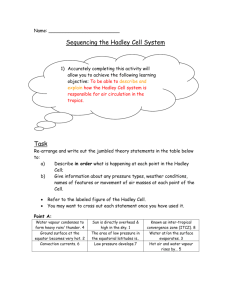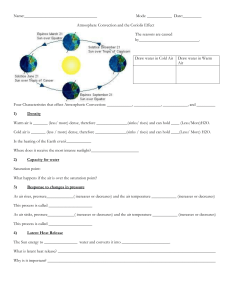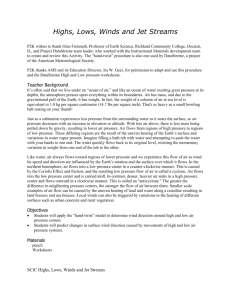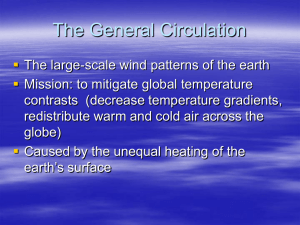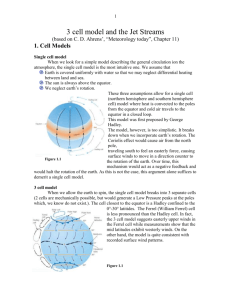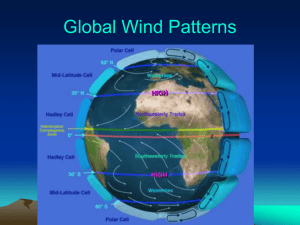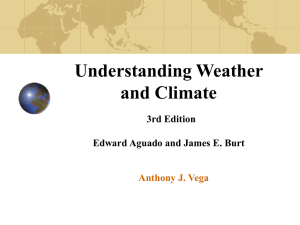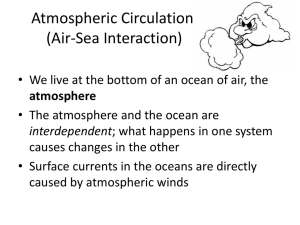Intro Meteorology - LunsfordEnvironmentalScience
advertisement
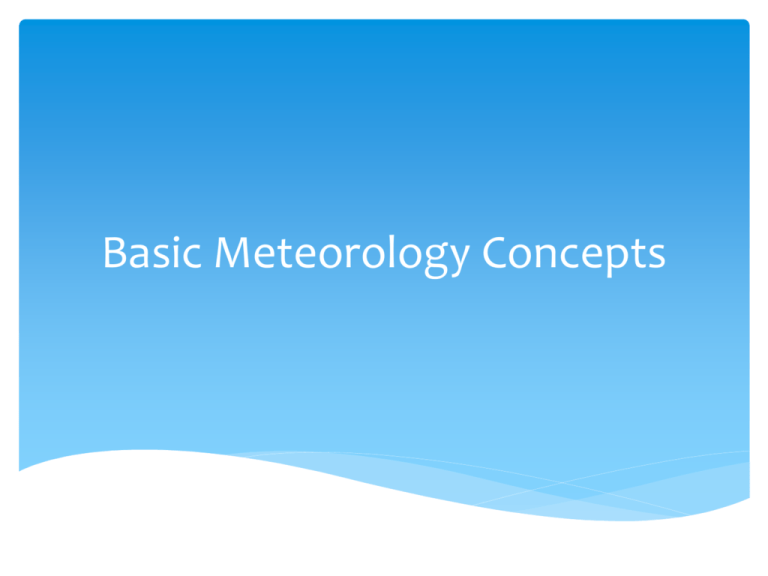
Basic Meteorology Concepts Spheres of the Earth Lithosphere Atmosphere Thermal Convection Objectives – Global Circulation Sketch the global pattern of winds in the three cell model Discuss vertical convection in the atmosphere Discuss the development of tropical cyclones Key terms: Hadley cell, ITCZ, cyclones, anticyclones and adiabatic Introduction to Meteorology: Low Pressure High Pressure Cyclonic Turning (counterclockwise): Convergence leads to upward vertical motions. Anti-Cyclonic (clockwise) Turning: divergence leads to downward vertical motions. Cold Air Warm Air Source: USA TODAY research by Chad Palmer, Graphic by Kevin A. Kepple Which one is the high pressure? The low pressur Which one is the high pressure? The low pressur Associated with deteriorating weather. Clouds form; lots of precipitation. Associated with fair weather, clear to partly cloudy skies. No significant weather. Starting assumption: Poleward heat transfer Mid-Latitudes Radiation imbalance Low and High Pressure centers Manifestation of the need to move heat poleward to maintain balance Air moves poleward Picks up heat from the oceans and continents below Rises at low pressure regions (such as the equator) Moves poleward taking its heat load with it Atmosphere moves ~1.5x more heat than oceans Global Atmospheric Circulation Single Cell Model 3 Assumptions: 1. Earth’s surface covered with water 2. Sun is always directly over the equator 3. Earth does not rotate Thermally direct cell – driven by the sun Too simplistic Where are Highs & Lows located? Single Cell Model Single Cell Model Meteorology Today by C. Donald Ahrens One-Cell Model If no net heating at any latitude: poleward export of heat towards cooler latitudes Simple wind system: surface winds blow from the polar high to the equatorial low The air at the equator heats up, becomes less dense and returns to the poles at the top of the troposphere where it cools and sinks This is model of simple earth with no rotation—How is the 3-cell Model different? Three Cell Model Takes the first two assumptions of the single-cell model, but the earth rotates Breaks down into three cells: Hadley cell, Ferrel cell and the Polar cell (Vertical view) Where are the high and low pressures located? Accounts for Coriolis Force and variations with latitude Three Cell Model Hadley Cell Ferrel Cell Polar Cell A quick digression: Coriolis Force Effect of the Coriolis Force Deflect currents or winds towards the right in NH; towards the left in SH Winds flow toward equatorial lows Equatorward winds = Trade Winds Note: WINDS are named for the direction that they are blowing FROM CURRENTS are named for the direction that they are flowing TOWARDS Coriolis “Force” facts: The apparent deflection of objects moving over the Earth's surface w/o being frictionally bound to it. An “apparent” force due to the rotation of the earth. The magnitude of the Coriolis force increases from zero at the Equator to a maximum at the poles. f = 2 Ω sin Φ Ω = angular rotation rate of the earth Φ = latitude It acts at right angles to the direction of motion Deflections to the right in the Northern Hemisphere Deflections to the left in the Southern Hemisphere Hadley Cell: Three Cell Model 4 Major areas of High Pressure: ~30o lat & poles (Subtropical & Polar Highs) 3 Major areas of Low Pressure: Near equator & ~60o lat (ITCZ & Subpolar Lows) Atmospheric Pressure Bands Be able to sketch the 3-cell model!!
